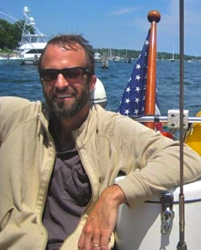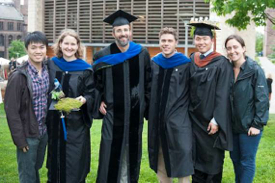Alum credits VIMS with jumpstarting career
Peter Raymond arrived at the Virginia Institute of Marine Science in 1995 in an old Volkswagen van with just his dog, his few worldly possessions, and a general interest in carbon cycling within rivers and estuaries.
 A 1999 alumnus of the Ph.D. program at VIMS, Raymond is now an internationally known expert in the
earth, aquatic, and marine science communities—and he is giving credit where credit
is due: to his alma mater.
A 1999 alumnus of the Ph.D. program at VIMS, Raymond is now an internationally known expert in the
earth, aquatic, and marine science communities—and he is giving credit where credit
is due: to his alma mater.
“Each step that has led me to where I am in my professional career as a scientist and researcher has been crucial,” he says, “but it was the research and publications that came out of my dissertation at VIMS that were critical to getting me where I am today.”
Raymond is now a professor of ecosystem ecology at the Yale School of Forestry and Environmental Studies, and has spent the majority of his scientific career studying the carbon cycle. “I’m still studying my undergrad senior thesis,” he laughs.
Raymond’s research at Yale focuses on biogeochemistry, concentrating specifically on carbon and nitrogen cycles within aquatic systems. He and the graduate students in his lab use natural radioactive tracers to study how natural and human processes control the concentrations of carbon and nitrogen within ecosystems, and to track the movement of these elements between land, water, and air. Their work has fundamentally altered scientists’ understanding of the source and fate of river-borne carbon, with important implications for the global carbon budget and possible responses to human-induced climate change.
During his research career, Raymond has collected samples around the world—from the York River in Virginia to the Mississippi River, to the Arctic Ocean. He has even studied samples collected in the Amazon. His research has led to more than 40 highly cited publications, including several in the prestigious journal Nature.
Jim Bauer, former professor of marine science at VIMS and Principal Investigator at The Ohio State University, was Raymond’s advisor and played a key role in his decision to enroll in the College of William & Mary’s School of Marine Science at VIMS.
“Within a year of working with Pete, I realized that I had an unusually and intuitively bright scientist and researcher on my hands,” says Bauer. “He interacted with the faculty members at VIMS as a seasoned colleague rather than a new graduate student.”
 Being treated like a colleague is, according to Raymond, one of the
greatest strengths of the Institute. “The number of scientists with expertise
on the coastal area all being within walking distance of each other was a great
facet of VIMS,” he says. “I would kick
around from office to office showing my data and discussing what I had found. I
hit the ground running as soon as I arrived.”
Being treated like a colleague is, according to Raymond, one of the
greatest strengths of the Institute. “The number of scientists with expertise
on the coastal area all being within walking distance of each other was a great
facet of VIMS,” he says. “I would kick
around from office to office showing my data and discussing what I had found. I
hit the ground running as soon as I arrived.”
Bauer and Raymond collaborated on an assortment of research publications while at VIMS, including one in Nature—an international science journal—that has become a classic in their field and has been cited more than 250 times to date. “Pete churned out a mind-boggling amount of innovative research while pursuing his degree, in addition to six peer-review papers in top-notch journals,” says Bauer. “He has been the most unique and talented student I have advised in my career.”
Raymond’s professional accomplishments were recognized in 2005 when he received the Cronin Award from the Estuarine Research Federation, an honor that is given to an estuarine scientist who shows great promise early in his or her career. A year later, Raymond was recognized once again with a CAREER grant for Faculty Early Career Development from the National Science Foundation. This prestigious grant is awarded to junior faculty who exemplify the role of teacher-scholars through outstanding efforts in both research and education. “It was nice to be recognized not only for the work I have done, but to feel like they were investing in me as a scientist,” says Raymond. “It was a real honor.”
“How Pete came by his innate sense of earth and ocean science and carbon cycling isn't entirely clear to me, but part if it had to do with his ability to see these systems as complex puzzles that he enjoyed playing with and putting the pieces together in his mind,” says Bauer. “My enjoyment in having him as a graduate student and seeing the places he has gone with his Ph.D.—including his impressive tenure at Yale—has spoiled me for the rest of my career!”
As a result of Raymond’s scientific maturity and his passion for research, Bauer suggested that he bypass his Master’s degree and go straight for the Ph.D. He did so—and then managed to complete the program in just four years.
Among Raymond’s fondest memories of VIMS are the times spent on the York River. “We got to spend a lot of time on the water,” he says. “It is such an amazing strength to have access to the water and be able to just go out on a boat and collect data whenever you want. If I went out one day and accidentally screwed up all of my samples, I could turn around and go out the next day and get some more. It can really accelerate the whole research process.”
The combination of his undergraduate education, work experience, and the knowledge he gained at VIMS helped push Raymond in the direction of his true calling—to be a scientist and professor who educates the next generation of students showing up to graduate school with just their dog and a love of science.
